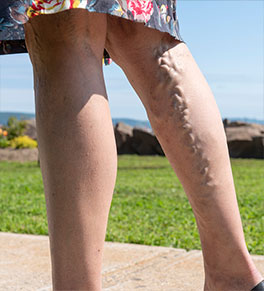Should I worry about my varicose veins?

At least 3 in 10 U.S. adults suffer from varicose veins — those swollen, often twisted blood vessels that lie just beneath the skin, usually on the legs and feet. They occur more often in women than men and they are more common in Western and industrialized countries.
Varicose veins are usually not life-threatening, however they can be lifestyle limiting. Many people seek treatment because they regard them as unsightly or embarrassing. But they can also lead to more serious health issues or interfere with physical activity.
Some people experience aching, itching, tingling or burning sensations and leg heaviness, symptoms that can be eased by elevating the legs or wearing compression stockings.
Others may develop swelling, ulcers, skin discoloration and a related condition called chronic venous insufficiency, in which blood pools in the lower leg. There is also a small risk for developing blood clots in one of the major veins in the leg.
Live Well asked Dr. Isabella J. Kuo and Dr. Mark A. Smith, board-certified UCI Health vascular surgeons, to explain what causes varicose veins and when you should consult a doctor.
What are varicose veins?
Veins are the circulatory system’s highways to bring blood back to the heart. Varicose veins develop when the small valves that regulate blood flow stop working properly or when there is an obstruction called deep venous thrombosis.
The valves in the legs’ saphenous veins normally close when we sit or stand. When they become weak, blood that is held in the valves while sitting or standing flows back toward the foot and ankle through the weakened varicose veins.
Similarly, with deep venous thrombosis, there is increased pressure on other veins that can lead to the development of varicose and spider veins.
A varicose vein is greater than three millimeters in diameter, about the size of a cotton swab tip. Spider veins are smaller and often appear as bluish, discolored areas on the skin.
Who gets varicose veins?
Anyone can get varicose veins, but certain people may be at higher risk. Risk factors include:
- A family history of varicose veins
- Obesity and/or being inactive
- Smoking
- Pregnancy
- Oral contraceptive pills or hormonal therapy
- Leg injuries or trauma, which can lead to valve reflux and varicose veins
Signs and symptoms
Varicose veins can become engorged and unsightly. Other common symptoms include:
- Pain at the sites of the varicose veins
- Leg swelling
- Leg heaviness
- Itchiness
- Changes in skin color around the vein
- Burning or throbbing sensation
- Worsened pain after sitting or standing for prolonged periods
In certain patients, complications can arise, including bleeding and phlebitis. In rare cases, blood clots can develop. However, having varicose veins does not increase the risk of deep venous thrombosis.
When is it time to see a doctor?
Patients can be seen anytime but it’s important to seek care when they start to have symptoms. It’s best to consult a vein specialist such as a vascular surgeon for any serious symptoms.
Along with taking a detailed medical history and conducting a physical examination, the vascular specialist will want an ultrasound test to examine the venous system for signs of deep venous thrombosis and venous insufficiency.
After making sure that no arteries are compromised, doctors will recommend that most patients begin with maximum conservative management. This means wearing compression stockings at varying strengths for at least six weeks, along with frequent leg elevation and regular exercise.
Often the challenge is correlating the ultrasound findings with the patient’s symptoms. The presence of reflux in the veins alone does not necessitate an operation if the patient has no symptoms.
Are there effective treatments?
In patients whose varicose veins are caused by reflux in the great saphenous vein, treatment options include open and endovenous procedures.
Open procedures include tying off, then removing the great saphenous vein.
Endovenous treatments can be categorized into thermal and non-thermal procedures done within the vein. Thermal procedures include radiofrequency or laser ablation of the saphenous vein. Nonthermal procedures include venous glue or the use of an ultra-thin catheter to deliver a chemical solution to close the vein.
Other options for managing varicose and spider veins include sclerotherapy or foam sclerotherapy, which involves injecting the vein with a solution that causes it to close, and phlebectomy, a minimally invasive procedure to remove veins near the skin’s surface.
Both open and endovenous procedures are effective. Endovenous procedures have a high success rate of initial vein closure at more than 95% with fewer complications. They are now being done more often than open procedures.
How long do the treatments take?
Most varicose and spider vein treatments are quick, in-office procedures. The treatments are minimally invasive, generally take less than an hour and are virtually painless. However, it is a multistep process that can take days, if not weeks to complete.
Most treatments require little to no recovery downtime but may result in minor swelling or bruising. Many patients prefer treatment during the fall and winter months when wearing long pants or skirts can hide the effects until they fade. Compression stockings, which are often needed for a brief time to promote healing, also can be quite warm.
Varicose veins and venous insufficiency cannot be cured but they can be effectively managed. Talk to your vascular surgeon about the risks and benefits of varicose vein surgery. In general, for patients with significant symptoms or related ulcers, the benefits of treatment may outweigh the risks.
Most treatments are covered by insurance except isolated spider veins that could be treated with sclerotherapy, a condition that is considered cosmetic. All the other treatments are usually covered with the appropriate documentation.
Learn more about UCI Health Vascular and Endovascular Surgery Services ›
Explore further
Browse more blog posts by topic.




